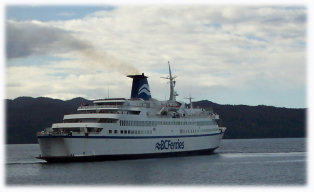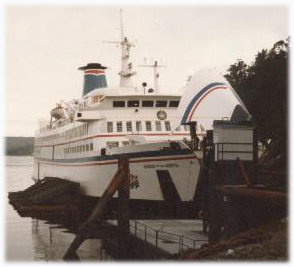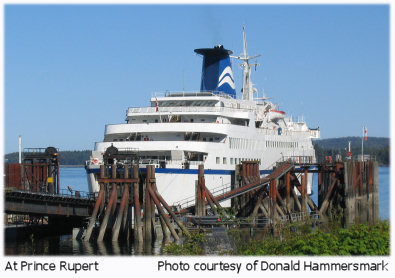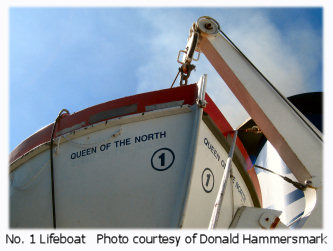
|
Queen of the North
OverviewToday, the Queen of the North lies 420 meters below the waves of Wright Sound on British Columbia's Inside Passage. When she was afloat, she was the fastest and most beautiful ship in the fleet. The Queen was one of two cruise-type ferries operated by BC Ferries on its northern routes until her sinking on March 22, 2006. The newer of the two, the Queen of the North mainly operated from late spring to early fall on the Inside Passage route, and when needed on the Prince Rupert to Skidegate (Queen Charlotte Islands) route. The summer day-cruise Inside Passage trip is especially popular with tourists; 274 nautical miles and approximately 15 hours of spectacular coastal scenery.Once the flagship and pride of the fleet, the Queen of the North was luxurious compared to most of the other ferries on the coast. The ferry featured many amenities: the Evergreen Buffet, Dogwood Bar, Passages Gift Shop, Medical Room, Lighthouse Cafe, several lounges including a pay lounge, a video arcade, a kids room, and 46 staterooms. The ship was accessible to people with disabilities. There were three passenger decks and plenty of room on the outside to enjoy the beautiful scenery passing by. To enable the ferry to hold additional cars, it was equipped with a raise-able platform on the vehicle deck. The Queen of the North along with the Queen of Prince Rupert had bows that raise while docked bow-first to allow traffic to load and unload via the front of the vessel.
 The Queen of the North (and all the other northern vessels) was a "single compartment ship," that is if only one of the hull's several watertight compartments is flooded the ferry should stay afloat. The began to be considered unsafe in the late 1990's and the ferry was due to be replaced before 2012 when Transport Canada plans to enforce new regulations. While this has been considered by some to be a contributing factor in the speed in which the ferry sank in 2006, it is unlikely that even a "multiple compartment" vessel would have stayed afloat given the damage done in the collision.
The Queen of the North (and all the other northern vessels) was a "single compartment ship," that is if only one of the hull's several watertight compartments is flooded the ferry should stay afloat. The began to be considered unsafe in the late 1990's and the ferry was due to be replaced before 2012 when Transport Canada plans to enforce new regulations. While this has been considered by some to be a contributing factor in the speed in which the ferry sank in 2006, it is unlikely that even a "multiple compartment" vessel would have stayed afloat given the damage done in the collision.
The Queen of the North was powered by two 7,800 horsepower diesel engines which turned two variable pitch propellers. The ship was the fastest in the BC Ferry fleet, with a service speed of 19 knots and a maximum speed of 23 knots. In the event of a serious emergency, evacuation was through a Jacobs Ladder system to access life rafts at water level. The Queen of the North had four evacuation systems, which have a combined capacity of 750 people. In addition to the life rafts, there were two 53-person life boats, and a 5-person rescue boat. Unlike ferries on the south coast, the Queen of the North 's crew live on board the vessel. Each crew group is divided into two 12-hour shifts. There are two complete crews, each one working 14 days on, 14 days off. With a crew ranging from 60-65, the Queen of the North has the largest crew of any ferry in the fleet.
HistoryThe Stena Danica was built in 1969 in Bremerhaven, Germany. Built for Stena Lines (Sweden), the ferry was put into service between Stockholm, Sweden and Copenhagen, Denmark. There is a postcard showing the Stena Danica in G�teborg, Sweden as well, so it is likely that she was used on other routes as well.The Stena Danica was purchased by BC Ferries in 1974 for $13.8 million because of a shortage in ships and capacity. She was immediately renamed Queen of Surrey and put into service between Horseshoe Bay and Departure Bay. The single-ended ship was found unsuitable for the short routes on the south coast. For several years the Queen of Surrey was parked at the Deas Dock maintenance facility. In 1980 the ferry underwent a major overhaul to prepare her for the northern routes and she was renamed the Queen of the North . Her first trip between Prince Rupert and Port Hardy was on May 29th, 1980.
 As the flagship of the fleet, the
Queen of the North
was sometimes pressed into special duty in the 1980's. On May 1, 1986, the ferry took Prince Charles and Princess Diana from Nanaimo to Vancouver to open the Expo '86 world fair. The next month, on June 11, the ferry also transported vice-president George Bush (Sr.) from Victoria to Vancouver to visit Expo '86. On 'Port Day' in 1988, the
Queen of the North
was open for public tours at Ballantyne Pier.
As the flagship of the fleet, the
Queen of the North
was sometimes pressed into special duty in the 1980's. On May 1, 1986, the ferry took Prince Charles and Princess Diana from Nanaimo to Vancouver to open the Expo '86 world fair. The next month, on June 11, the ferry also transported vice-president George Bush (Sr.) from Victoria to Vancouver to visit Expo '86. On 'Port Day' in 1988, the
Queen of the North
was open for public tours at Ballantyne Pier.
The Queen of the North was pulled out of service in mid-October 1994 following the findings into the causes of the sinking of the Estonia in the Baltic Sea. On September 28, 1994, the Estonia ferry sank between Estonia and Sweden, killing 852 of the 989 passengers on board. The cause was found to be a fault in the bow visor of the vessel which broke off in heavy seas allowing water to enter the car deck. Since the Queen of the North and Queen of Prince Rupert have similar designs, both ferries were pulled from service on the Friday before the Thanksgiving long weekend to have their bow doors welded shut. In the process, passengers and freight were stranded on the Queen Charlotte Islands. The ferries returned to service less than a week later. This emergency safety precaution was later undone and additional safety measures were put in place to compensate.
 In October, 2000, the
Queen of the North
underwent a major refit that saw the interior of the vessel refurbished, the cafeteria redesigned, and the emergency equipment updated.
In October, 2000, the
Queen of the North
underwent a major refit that saw the interior of the vessel refurbished, the cafeteria redesigned, and the emergency equipment updated.
The ferry played the role of ambulance on July 15, 2005. A man at Hartley Bay (a small outpost along the Inside Passage south of Prince Rupert) suffered what was believed to be a heart attack. Due to bad weather and low clouds, an air ambulance evacuation was impossible. The nearby Queen of the North was diverted to pick the man up and take him to Prince Rupert. With the help of the ferry and two doctors and two nurses on board at the time, the man made it safely to a hospital. Little did anyone know that less than a year later, the roles of this story would be reversed.
Her Last DayThe most tragic of all accidents involving BC Ferries occurred in the early morning of March 22, 2006. At around 0025, the Queen of the North hit Gil Island at full speed and after drifting near the island for about an hour and 15 minutes sank in Wright Sound. The ferry was southbound, having left Prince Rupert the evening of the previous day on her way down to Port Hardy. The accident occurred about 130 km south of Prince Rupert after it had exited Grenville Channel. Although the weather at the time was wet and windy, it is unlikely that it played a role in the incident.Minutes after hitting the island, the crew sent out a Mayday call and shortly after that the command was given to abandon ship. There were 101 people on board the ferry that night. It is a credit to the crew that 99 of those people made it off the ship safely onto lifeboats and liferafts. Credit is also due to the inhabitants of nearby Hartley Bay, who were the first to respond to the Mayday. Dozens of boats went out to the stricken ferry, arriving around the time that the Queen of the North sank stern-first beneath the waves. Passengers were quickly picked up by boats from nearby Hartley Bay and by the Canadian Coast Guard Vessel Sir Wilfred Laurier , which had arrived at the scene shortly after the sinking. Sadly, two of the passengers on board the Queen of the North that night were never found.  A few hours later, British Columbians woke up to news that the
Queen of the North
had sunk in the waters of Wright Sound. News media quickly flew to Prince Rupert and Hartley Bay to cover the story. The crew and passengers in Hartley Bay were transferred to the
Sir Wilfred Laurier
and taken to Prince Rupert. Over the next few days officials worked to contain oil leaking from the vessel. A search for the two missing passengers failed to find anything. Transport Canada financed at least two dives to the vessel, taking photos and videos, and retrieving equipment that to help further the investigation.
A few hours later, British Columbians woke up to news that the
Queen of the North
had sunk in the waters of Wright Sound. News media quickly flew to Prince Rupert and Hartley Bay to cover the story. The crew and passengers in Hartley Bay were transferred to the
Sir Wilfred Laurier
and taken to Prince Rupert. Over the next few days officials worked to contain oil leaking from the vessel. A search for the two missing passengers failed to find anything. Transport Canada financed at least two dives to the vessel, taking photos and videos, and retrieving equipment that to help further the investigation.
BC Ferries released their internal report on the sinking on March 26, 2007. The corporation concluded that human error was the cause of the accident, laying most of the blame on 3 crew members who refused to cooperate with their investigation. A month later they were fired from BC Ferries, a move opposed by the union. On March 12, 2008, the Transport Safety Board's final report on the sinking was released to the public. While not pinpointing the exact cause of the collision, the report highlighted a failure to follow safety proceedures, human oversight, and a failure to properly use all navigation equipment as contributing factors. Several recommendations followed the major investigation including:
Left with only one full-time northern vessel, BC Ferries purchased the Sonia (renamed Northern Adventure ) in September 2006. The new ferry, although inferior in most respects to the Queen of the North , entered service on March 31, 2007 restoring normal ferry service to the north coast.
Origin of NameQueen of the North - "The North" refers to the remote and sparsely populated north half of the province. The north coast extends from northern Vancouver Island to the Alaska Panhandle. Except for a few small cities, the coast is mainly inhabited by First Nations people. Timber is the main industry along the coast, but fishing, fish farming, and ecotourism are also present. Many areas of the north coast are protected through national and provincial parks.
For Further Reading

|